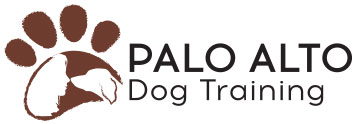Leashes and Long-Lines
September 9, 2015
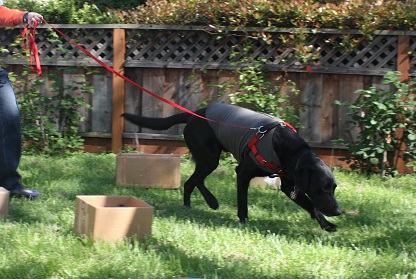
When I took my very first Nose Work class, I bought a 15′ nylon lead. It was cheap. It was lightweight. It came in a pretty red. I thought I was done buying Nose Work leashes and long-lines.
Fast forward to today. I keep finding excuses to buy new leashes: new colors, new materials, new lengths, new widths, new features. So how do you decide what to buy? Do you need more than one?
Leashes and Long-Lines: What are they made of?
Nylon
My first Nose Work long-line was nylon. I soon found that it was too lightweight for me and my Labrador, Tigger. It cut into my hands, and gave me rope burns every time prey-obsessed Tigger would impulsively leap at a critter. It got tangled easily. I had a hard time keeping it from dragging on the ground. If you have a small dog, nylon might be perfect for your team. I do not recommend it for strong, impulsive Labradors.
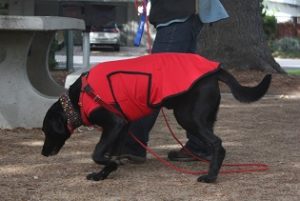
Leather
Leather is a popular choice for professional and sport detection teams. You will want a leather that’s supple and soft, but still strong. Leather feels nice on the hands. Good leather lasts a long time, and gets softer and better with age. My favorite 8′ Nose Work lead is leather. However, leather is fairly expensive, and the longer leather leads are quite pricey.
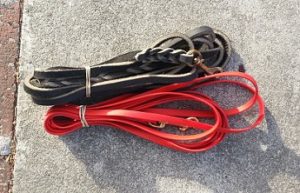
Rain
While I love the leather leashes, I find they become slimy and unpleasant when soaked with water. In fact, rain makes most lines slippery, and harder to hold onto wet. The Redline K9 Suregrip leash has rubber strands woven throughout, making the leash easy to manage no matter how wet they get.

Biothane
I confess, I’ve been collecting biothane leads. Like leather, it feels nice on the hands, and doesn’t tangle easily. Biothane is sometimes called fake leather, but there are differences. It’s a bit stiffer than the best leather. It’s washable, easy-care, and waterproof. It’s much cheaper than leather, so you can buy more of them.
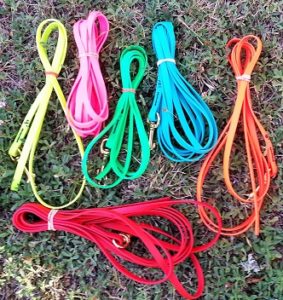
You can also purchase round biothane leashes and long-lines, which many people prefer to the flat biothane discussed above. This round leash is actually a rope coated with biothane. These leashes are popular with handlers of mid-sized dogs, because they are lighter-weight. They are also popular with handlers of large dogs, as the round shape is easier on the hands than the flat, when the large dog moves too quickly to be easily followed.
Like other biothane leashes, they’re washable, easy-care, waterproof, and affordable.
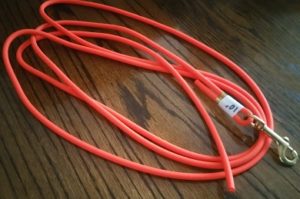
All of the above biothane lines came from Palomine Lines, a popular source.
Small dogs under 15 pounds may prefer another source, suggested by alert reader Mary Strauss. The Palomine Lines’ hardware was too heavy for her very small dogs. She is very happy with the biothane leashes and long-lines from Carolyn Barney. For the tiny dogs, choose the narrowest width leash, and the very lightest hardware.
Paracord
If your dog is on the smaller side, you’ll benefit from a lightweight leash. Many small-dog handlers swear by paracord. A quick internet search will generate instructions for a do-it-yourself paracord lead. Or, you can buy one that’s already made. I’ve heard great things about Want Knot Paracord Dog Leashes in Santa Cruz; they also have an Etsy store.
Fleece
On the other end of the spectrum, some large dogs race around, and it’s jarring when they repeatedly bump into the end of the leash. Fleece is stretchy already, and when it’s braided, the lead becomes even more stretchy. The ability to absorb shock makes the search more pleasant for both the handler and the canine. Downside: not great in the rain.
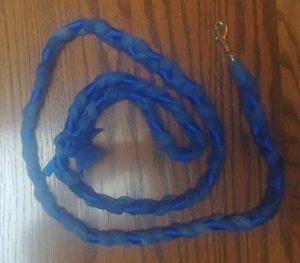
Braided fleece leashes are available on Etsy, and also at many Agility meets and practice locations.
Other choices
Climate may also influence your choice. Live in California? You’ll want a lead that won’t collect fox-tails and burrs. Live in the Pacific Northwest? In that wet climate you might want leashes and long-lines that are sticky and/or knobby, to make up for your wet slippery hands.
A reader, Wanda Rambart, has contacted me to talk about wool leashes. She says, “I have been doing Nose Work with my dog for 3 years now and love it! I’ve discovered wool leashes — I had one handmade without a handle, and it is the perfect weight, soft to hold, and I prefer it to my leather leash.” Thank you Wanda for your suggestion!
I’ve tested nylon, leather and biothane leashes and long-lines. Leather and biothane are by far the most common, and I’m happy with both. If you use, and love, a Nose Work long-line made of something else, we would love to hear from you.
To loop, or not to loop
All of us are familiar with leashes that have a handle, or loop, at the human end. It’s convenient, and makes it easier to hold onto our dogs’ leashes and long-lines. So why would anyone want a leash without a handle?
Sometimes, in the quest for the odor source, the dog will take a path that is difficult for us to follow, for instance, underneath a table or through thick shrubbery. You don’t want to pull the dog off odor, but you can’t follow the dog. So, you might decide to drop the leash, hurry around, and quickly pick it up on the other side. A leash with no loop is likely to slide through obstacles, without snagging and trapping the dog.
There isn’t a right or wrong loop answer. What gives you the most peace of mind? Do you prefer the extra security of the handle around your wrist, or the ease of knowing the leash is unlikely to get snagged if dropped? Try both, and see which you like better. If you can’t decide… buy one of each.
Length
What’s the ideal length for a particular dog working with a particular handler on a particular day? Is the dog so fast you can’t keep up, and need lots of leash to give him/her room to work? Do you prefer to direct the search, let your dog take charge, or a combination? Does your dog love working independently, or would your dog prefer the support of knowing you’re nearby? How big is the search area? Are there lots of obstacles you’ll need to thread through? Does your dog move more quickly in cold weather (the first picture below) and slow down in the heat (the Vehicles photo)? Are you searching an area (Interiors or Exteriors), or are you searching things (Vehicles or Containers)?
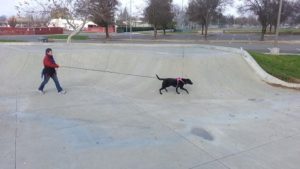
Most of us end up with two or three favorite lengths for our leashes and long-lines. Those lengths depend on how each particular team works best. The choice for each search will depend on the specifics of that search. For searching large open areas, most people prefer 10′ to 15′. Most people prefer 6′ to 12′ for smaller or indoor areas. For searching containers, some people prefer a 4′ leash. Experiment with different lengths in a variety of search types, before you decide what works for you and your canine teammate.
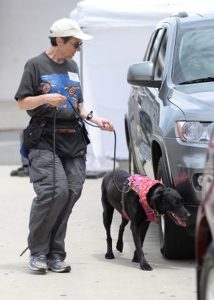
Accessorizing
Leather and biothane leads are often hand-made to order. There are several variations.
-
- Width. Most common: the 3/8″, the 1/4″, and the 5/8″. My personal preference is the 3/8″. Try different widths, and see what your preference is.
-
- Hardware. Do you want a sturdier snap? A different kind of clasp? You can likely be accommodated.
- Grommets, braiding, or knots. How will you know, without looking, that you’re nearing the end of the leash? If you choose to forego a loop, you can add tactile clues near your end of the lead.
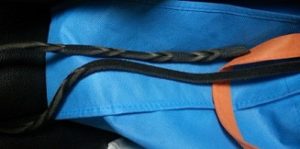
- Braided knots for additional control. One of my students has a very energetic Golden Retriever who darts in various directions quickly and seemly at random. To help her retain control of the leash, she requested a few braided knots spaced out along the lead, to give her something easy to grab onto, should she need it.
Leashes and Long-Lines
There are so many choices. Leather, nylon, biothane, or something else? How wide? How long? Standard hardware or custom? Handle or no handle?
I’d love to hear about your favorite Nose Work leash. What’s it made out of? How long is it? Does it have special features? Would you recommend it to others? Do you have any you hate? Tell us why in the comments below.
Copyright 2015 by Linda Fletcher
